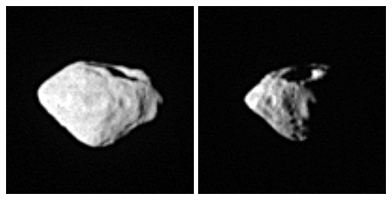The Rosetta Spacecraft Flyby of the Asteroid Steins
Rosetta Space Mission: Steins Flyby
The Rosetta spacecraft’s close encounter with asteroid Steins is one of the most significant astronomical events in the history of space research. With the launch of the Rosetta spacecraft in March 2004, scientists were absolutely certain that it will gather enough information about the asteroids size, shape and volume as well as its rotation rate and reflectivity of the surface. The Rosetta fly-by of asteroid 2867 Steins occurred on September 5, 2008.
The closest encounter with Steins:
The closest encounter took place at 20:58 CEST ground time; at a distance of approximately 497 mi. Rosetta gathered scientific observations of Steins, while still in flyby mode, and established a radio contact at 22:14 CEST with the Rosetta control room at ESA’s European Space operations Centre via NASA’s Goldstone antenna, thus confirming a smooth flyby at a relative speed of 8.6km/s. The radio signal from Rosetta took 20 minutes to reach the ground.
Two years ago, in March 2006 the Rosetta Orbiter Imaging System (OSIRIS) on board Rosetta observed something interesting. From a distance of 159 million kilometers, the Osiris camera was able to determine (by recording variations in the asteroid’s brightness) that the tiny asteroid spins around its axis for about six hours.
Wealth of Information:
The European Space agency obtained the first images of the asteroid on 6 September 2008 after the flyby occurred. The spacecraft transmitted the images to the control team in Darmstadt, Germany. The images of Steins were quite spectacular.
According to the raw data derived from images of the asteroid, scientists came to a conclusion that asteroid steins had a chain of impact craters. These craters must have formed due to a continuous impact of a meteoroid stream. Craters can help determine the age of an asteroid. Scientists have spotted several small craters and two big craters, one crater having a diameter of 2km. This indicated that the asteroid must be very old and can give access to a wealth of information about the solar system. The images will also help scientists comprehend the odd brightness of the comet.
Some More Information about Asteroid Steins
Asteroid Steins is classified under a rare class of E-type asteroids. The asteroid is quite tiny and has a diameter of 4.6 km. These asteroids are quite irregular in shape and are mostly found in the inner part of the main asteroid belt located between Mars and Jupiter. The fact that it has not been directly observed by an interplanetary spacecraft makes it more interesting. These types are assumed to be composed of silicate minerals with little iron content and have probably originated from the mantle of larger asteroids which were destroyed long ago.
With more such information and data gathered from asteroid steins in the coming days, scientists hope to decipher the early history of our solar system. It will also provide the key to the origins and evolution of planets. Thanks to Rosetta!
References
Credits:
https://www.esa.int/esaMI/Rosetta/SEMIXGO4KKF_0.html
https://www.esa.int/SPECIALS/Rosetta/SEMNMYO4KKF_0.html
https://www.esa.int/SPECIALS/Rosetta/SEM5EZO4KKF_0.html
https://www.esa.int/SPECIALS/Rosetta/SEMNMYO4KKF_0.html
https://www.esa.int/esaMI/Rosetta/SEMIXGO4KKF_0.html
Image References:
ESA/NASA
This post is part of the series: The International Rosetta Mission History and Current Events
The Rosetta space probe was launched by the European Space Agency with the objective of rendezvousing with a comet and placing a lander on it in 2014. Recently it passed by a small asteroid, Steins, and provided some very useful data
